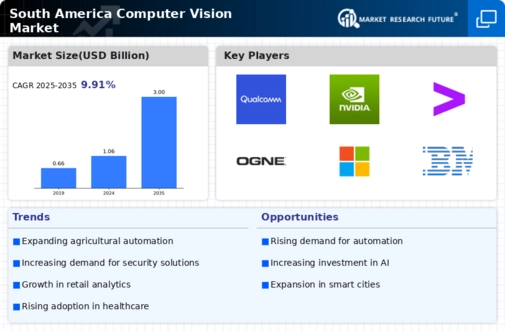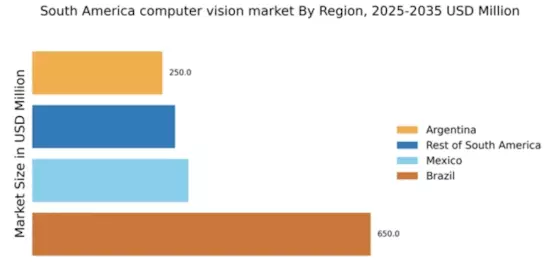Technological Advancements in AI
Technological advancements in artificial intelligence (AI) are playing a crucial role in the evolution of the computer vision market in South America. The integration of AI with computer vision systems enhances image recognition capabilities, enabling more accurate and efficient processing of visual data. This synergy is particularly beneficial in sectors such as agriculture, where AI-driven computer vision applications can monitor crop health and optimize yields. The market for AI in computer vision is projected to grow at a CAGR of 20% over the next five years, indicating a robust future for the industry. As businesses increasingly leverage AI technologies, the computer vision market is likely to experience significant growth.
Expansion of E-commerce Platforms
The rapid expansion of e-commerce platforms in South America is significantly impacting the computer vision market. As online shopping becomes increasingly popular, retailers are adopting computer vision technologies to enhance customer experiences. Features such as visual search and automated checkout processes are becoming standard. According to recent estimates, the e-commerce sector in South America is expected to grow by 25% annually, leading to a surge in demand for computer vision applications. This growth is likely to encourage retailers to invest in advanced technologies, thereby propelling the computer vision market forward. The integration of these technologies is anticipated to streamline operations and improve customer satisfaction.
Rising Demand for Security Solutions
The increasing need for enhanced security measures across various sectors in South America is driving the computer vision market. With crime rates in urban areas remaining a concern, businesses and governments are investing in surveillance systems that utilize computer vision technology. This technology enables real-time monitoring and analysis of video feeds, improving response times to incidents. The market for security cameras and related software is projected to grow at a CAGR of 15% from 2025 to 2030. As organizations seek to protect assets and ensure safety, the computer vision market is likely to see substantial growth, with investments expected to reach approximately $1 billion by 2027.
Increased Focus on Industrial Automation
The growing emphasis on industrial automation in South America is significantly influencing the computer vision market. Manufacturers are increasingly adopting computer vision systems to enhance quality control, streamline production processes, and reduce operational costs. These systems can detect defects in real-time, ensuring that only high-quality products reach the market. The industrial automation sector is projected to grow by 30% over the next five years, leading to a heightened demand for computer vision technologies. As companies seek to improve efficiency and competitiveness, the computer vision market is likely to benefit from this trend, with investments in automation technologies expected to exceed $2 billion by 2028.
Government Initiatives for Smart Infrastructure
Government initiatives aimed at developing smart infrastructure in South America are fostering growth in the computer vision market. Investments in smart transportation systems, traffic management, and urban planning are becoming more prevalent. These initiatives often incorporate computer vision technologies to analyze traffic patterns and improve public safety. For instance, cities are deploying smart cameras to monitor traffic flow and reduce congestion. The government is expected to allocate approximately $500 million towards smart city projects by 2026, which will likely boost the demand for computer vision solutions. This trend indicates a promising future for the computer vision market as public sector investments continue to rise.


















Leave a Comment